History on the Home Front
Here's a piece that I originally submitted for one of our publications here at the U.S. Marshals Service. It didn't quite fit the overall theme of the issue so I am sharing it here instead...
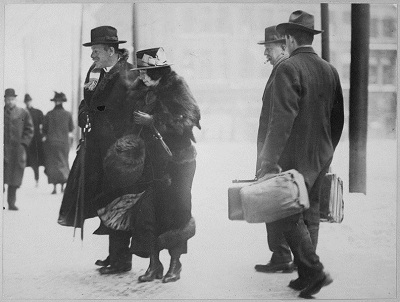
Ernst Kunwald in the custody of two U.S. Marshals, 1917
Once called “The Great War,” what we refer to today as World War 1 (WWI) has become a frequently overlooked conflict in the annals of American history. This major military action centered in Europe, beginning on July 28, 1914 and lasting until November 11, 1918. Much like its successor, WWI also assembled two opposing coalitions made up of the world’s largest superpowers: the Allies, including the United Kingdom, France, and Russia; versus the Central Alliance, made up of Germany, Austria-Hungary and Italy.
The United States entered the conflict in support of the Allies when President Woodrow Wilson issued a declaration of war against Germany on April 6, 1917. For the next 19 months the United States Marshals Service acted as a home front guardian while protecting the nation against the threat of enemy spies and saboteurs.
Much like today, U.S. Marshals worked closely with local law-enforcement officers while taking precautions against hostile acts. This included keeping a careful watch over German aliens who may have remained loyal to their homeland. U.S. Marshals were instrumental in the location and seizure of illegal weapons, explosives and radios that were harbored by enemy sympathizers. The agency also assisted with the preservation of the draft. This included the protection of Selective Service centers and the apprehension of draft evaders or those disrupting the draft process.
Securing America’s entryways and infrastructure was an essential duty during WWI. The U.S. Marshals provided security by maintaining restricted zones around shipping docks, steel factories, military bases and arsenals. They also enforced the government’s pass procedures that required German aliens to carry specially issued identification. In doing so, the United States Marshals Service was given the sole authority to arrest and detain enemy aliens.
This period witnessed one of the first attempted acts of domestic terrorism on America's infrastructure. On February 2, 1915 an attempt to bomb the Vanceboro International Bridge, connecting the Canadian province of New Brunswick to Maine, was conducted by a German agent named Werner Van Horne. The attack was masterminded by then spymaster Franz von Papen who later served as Chancellor of Germany in 1932 and as Vice-Chancellor under Adolf Hitler in 1933–1934.
Prior to conducting the mission it is said that Van Horne changed into a German army uniform to avoid being convicted of being a spy and executed. He then proceeded to the railway bridge over the St. Croix River with a suitcase of explosives. What happened next is chronicled in J.G. Bruce’s study of the incident titled “The History of McAdam 1871–1977:”
Horn proceeded to position a suitcase filled with explosives on the Canadian side of the bridge but was interrupted by an oncoming train and was forced to move out of its path. After he was sure it had passed he proceeded to reposition the explosives. However he was interrupted a second time by another train. Puzzled and not wanting to kill anyone, he waited until 1:07 a.m. on February 2 before again repositioning the bomb on a girder. Horn cut the fuse, this changed the time before the explosion from fifty minutes to only three. Horn lit the fuse with a cigar and somehow made it back to the Exchange Hotel through a gale in −30 °F temperature before the dynamite exploded. At 1:10 a.m. on Tuesday, February 2, 1915 the bomb exploded, blowing out windows across Vanceboro and St. Croix and exposing residents to the freezing air outside. Some iron beams on the bridge were twisted or bent but the damage was relatively minor.
Ironically, at least three Vanceboro residents had previously reported Van Horne’s suspicious behavior to the local U.S. immigration inspector who interviewed the German native at the hotel he was staying at. Van Horne calmly assured the examiner that he was merely a Danish farmer looking to purchase land in the area. The local sheriff for Vanceboro, along with two Canadian police officers who crossed the border to provide assistance, later detained Horn back at the hotel. He was interrogated by the Federal Bureau of Investigation for several days and signed a confession with an agreed-upon statement of facts where he revealed the details of his crime.
Van Horne was transferred over to the custody of the U.S. Marshals and led before a federal grand jury in Boston, Massachusetts at the United States District Court. He was indicted on March 2, 1915 for his most serious crime while in the United States, a charge of transporting explosives on a common carrier that also transported passengers for hire. His sentence was to serve 18 months at the Atlanta Federal Penitentiary in Georgia which he completed before being extradited to Canada in October of 1919, retried and sentenced to serve an additional 10 years at Dorchester Penitentiary in New Brunswick. Van Horne’s mental capacity soon deteriorated and he was judged to be insane in July of 1921 whereby he was released and deported back to Germany.
Unfortunately not all suspected aliens who ended up in U.S. Marshal’s custody were as guilty as Werner Van Horne. Such was the story of Ernst Kunwald, a gifted Austrian conductor who served as assistant conductor of the Berlin Philharmonic and was the conductor of the Cincinnati Symphony Orchestra and the Cincinnati May Festival. As an outbreak of paranoia and prejudice swept the nation many Germans were mistakenly identified as enemies of the state. In November of 1917, the Daughters of the American Revolution used their civic influence to instigate the forbiddance of a Kunwald symphony in Pittsburgh. Rumors quickly circulated challenging the conductor’s loyalties.
Kunwald was arrested in December of that year by the United States Marshals Service who released him from jail the very next day. One month later he was interned under the Alien Enemies Act and imprisoned at Fort Oglethorpe in Georgia. Fellow conductor Karl Muck later joined him lending credence to the theory that their unjust imprisonment was due to their spread of German music which may have been considered overly propagandistic. According to a memo drafted by J. Edgar Hoover, Kunwald had conducted the Star-Spangled Banner before one concert after telling the orchestra and audience (many of whom were German) that his sympathies were with his own country. Hoover’s claim was never substantiated.
By the end of the war the Central Alliance had been militarily and politically defeated and ceased to exist. The League of Nations was formed in the hope of preventing another such conflict although the European nationalism spawned by the war and the breakup of empires are generally agreed to be factors contributing to World War II. As America’s troops returned from the muddy trenches of the western front, the U.S. Marshals maintained their mission until Armistice was declared in November of 1918. The following month all restrictions were lifted and federal law enforcement agencies returned to business as usual.
At the outset of war President Wilson told the American public that “We must all speak, act, and serve together.” There is no question that the United States Marshals Service met that directive with distinction. Over the course of the nation’s participation in WWI the agency investigated 222,768 violations of the selective service laws; registered 480,000 German enemy aliens; issued 200,000 permits to enemy aliens; arrested 6,300 enemy aliens under Presidential Arrest Warrants; and interviewed 2,300 enemy aliens in military camps.
BONUS: For a timeline of significant USMS contributions during WWI, visit The U.S. Marshals during World War I: Protection of the Home Front webpage.
Sources:
History - The U.S. Marshals during World War I: Protection of the Home Front
German Spy Who Tried to Dynamite Bridge to Be Deported". The New York Times. July 23, 1921
Bruce, J. G. (1979). The History of McAdam 1871–1977 (Vanceboro Bridge. Pages 149–150). McAdam: McAdam Senior Citizens Historical and Recreational Club.
Cincinnati Symphony Leader, an Austrian, Rearrested on Washington Orders. New York Times. January 13, 1918
Person of the Year 1862?
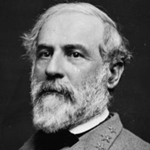 Like many of you I too spent my Saturday afternoon watching the live 6-hour broadcast of the Museum of the Confederacy’s Person of the Year: 1862 symposium on CSPAN-3 (Watch here). With a spring calendar that includes a documentary film shoot, multiple speaking engagements and a new book release, the last thing I want to do on a weekend is watch a bunch of Civil War historians wax the poetic about dead guys.
Like many of you I too spent my Saturday afternoon watching the live 6-hour broadcast of the Museum of the Confederacy’s Person of the Year: 1862 symposium on CSPAN-3 (Watch here). With a spring calendar that includes a documentary film shoot, multiple speaking engagements and a new book release, the last thing I want to do on a weekend is watch a bunch of Civil War historians wax the poetic about dead guys. I couldn’t pass this one up as it boasted a line-up that included Robert K. Krick, David Blight, James McPherson, Jack Mountcastle, and Emory Thomas. Unfortunately, as much as I respect these guys and enjoyed their talks, I couldn’t help but notice the drastically apparent ‘one-dimensionality’ of the entire event. What you had at the end of the day was a bunch of old white people, sitting in an auditorium together, listening to a bunch of old white people. It was an uber-cliché…a Civil War seminar, held in Richmond Virginia, with no racial or age diversity in attendance. I wonder if anyone other than a Confederate could win.
In addition, it seemed a bit too ironic that CSPAN filled in the 40-minute ‘lunchtime’ period of the broadcast by replaying the ground breaking ceremony for the Smithsonian’s new National Museum of African American History and Culture. I wonder if that was a conscious decision. The only other moment of diversity was David Blight’s portion in which he nominated Frederick Douglass for his Person of the Year. The other nominees were Krick’s nomination of Stonewall Jackson, McPherson’s surprise pitch for David Farragut, Gen. Mountcastle’s selection of George McClellan and Emory’s predictable choice of Robert E. Lee. All five speakers did admirable jobs presenting their arguments (although I thought the winner actually had the weakest).
At the conclusion of the day’s lectures, a poll was held among the audience who elected Lee in a landslide as their Person of the Year: 1862. Surprised? Nope. BTW: Lincoln won the title the previous year ‘1861’.
In between the lectures each historian took phone calls from TV viewers. In a perfect demonstration of everything that is wrong with debating Civil War memory one African-American caller compared Robert E. Lee to the Nazi war criminal Joseph Mengele and argued that he should be dug up, burned, and have his ashes scattered. A Good Ol' Boy immediately dialed in and spent his 2-minutes defending Confederate history. One caller questioned Lincoln’s sexuality while another brought modern politics into the conversation while taking a jab at the Republican Party. Emory, who was hilariously witty lost a ton of points with me when he glossed over the issue of Lee’s racism and actually referred to him as an emancipator.
That said, the fact that I was able to simultaneously watch a Civil War Sesquicentennial symposium and the ground breaking ceremony for an African-American history museum reminded me how great it is to be a historian in 2012, witnessing all of the growth in the nation’s efforts for historical preservation and presentation. I seem to constantly forget that.
Kevin Levin over at Civil War Memory was the first in the blogosphere to post about the MOC event and I could not agree with him more. He recommends that the committee assemble “a panel of younger historians, whose choices may not be so predictable.” He adds that “You have to include at least one woman and an African American. In short, perspective is everything when it comes to these kinds of events.”
It would be nice to see more diverse participants and attendees. It’s definitely time for that. The fact that Robert E. Lee won was a total disappointment for me. Looking at the audience I couldn’t help but feel that they would pick him no matter who was on the ballot. I would even predict that if you nominated Lee next year under the same circumstances he would win again.
This is not a slight at Lee, nor toward the people who participated in the event, but rather a criticism of the lack of diversity represented there. I would like to see them market these events towards a broader demographic and change the election's focus to be “The most unpredictable person of the year.” That would stir things up.
At the end of his post Kevin asked who would you nominate and named Benjamin Butler as his pick. I’m going way out of the box and selecting Ambrose Powell Hill. What!? Yes, here is my quick and dirty 6th-degrees of Kevin Bacon argument: A.P. Hill ordered one of the most amazing quick-step marches from Harpers Ferry to Sharpsburg, arriving in the ’11th hour’ of the Battle of Antietam, ultimately saving Lee’s Army of Northern Virginia from destruction and forcing a tactical ‘stalemate’.’ The repercussions of the outcome of the Battle of Antietam ultimately influenced President Abraham Lincoln to finally issue the Emancipation Proclamation. A.P. Hill’s actions at Sharpsburg therefore affected BOTH sides of the conflict tremendously and turned the entire focus of the war in 1862.
Yeah I know it’s a stretch, but definitely an unpredictable nominee. Let's hope that we see some surprises next year when they elect their Person of the Year: 1863.
Update: Pines Bridge project
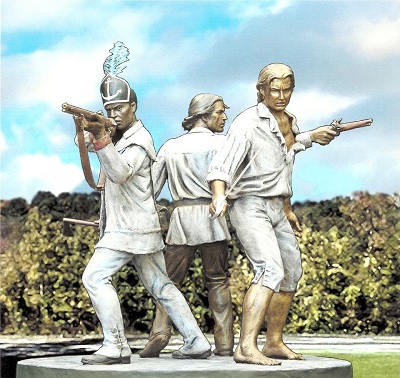
Our friend Michael Kahn just sent me an update on the Pines Bridge Monument Project:
The Pines Bridge Monument Committee, in conjunction with the Yorktown Chamber of Commerce, the Yorktown Historical Society, and the Yorktown Planning Department is pleased to announce the selection of a sculptor and design for the Battle of Pines Bridge Monument. On May 14, 1781, just after sunrise there was a surprise attack on the first Rhode Island Regiment headquartered at the Davenport House in Croton Heights. This regiment was comprised of African American, Native American and European American soldiers under the command of Colonel Christopher Greene.
After months deliberating and considering the diverse designs, we have entered into negotiations with renowned sculptor Jay Warren from Rogue River, Oregon. Mr. Warren's previous commissions include both portions of the New Jersey World War II Memorial, the New Jersey Korean War Memorial, Victims of Terrorism Memorial at the Raritan Bay Waterfront Park overlooking the World Trade Center Site; John Coltrane Monument in High Point, NC, and the Sojourner Truth Memorial in Northampton, MA among many others (www.warrensculpture.com).
As you can see by the artist's sketch, the anticipated sculpture is extraordinary. You can now purchase bricks in support of the project here. Congrats to Michael and his committee for proving that commemorating our collective history matters.
Vampires suck. Zombies don't.
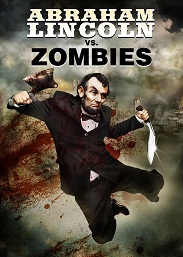 I’m sure many of you have heard about the upcoming film titled “Abraham Lincoln: Vampire Hunter.” As both a historian and a film producer I cannot believe something this absurd found its way to the big screen. I suspect that it won’t break any box office records once it’s released. The mere concept of our 16th president hunting down vampires is absolutely ridiculous and with the continued ‘sissyfication’ of these bloodsuckers (courtesy of the Twilight Series) I don’t anticipate much of a scare.
I’m sure many of you have heard about the upcoming film titled “Abraham Lincoln: Vampire Hunter.” As both a historian and a film producer I cannot believe something this absurd found its way to the big screen. I suspect that it won’t break any box office records once it’s released. The mere concept of our 16th president hunting down vampires is absolutely ridiculous and with the continued ‘sissyfication’ of these bloodsuckers (courtesy of the Twilight Series) I don’t anticipate much of a scare.
On the other hand, there is another film, VERY similar in scope, but much more believable. It is titled “Abraham Lincoln vs. Zombies” and already looks to be a winner. This historically-hysterical film stars our friend Bill Oberst Jr. (Sherman’s March) as the undead-slaying emancipator and is set for a May 22 release. According to the film’s promo:
While the Civil War rages on, President Abraham Lincoln must undertake an even more daunting task: Destroying the Confederate Undead. Oberst, known to over 60 million Facebook users as the cyber-stalker in Jason Zada’s viral Facebook application Take This Lollipop, says it is one of the best roles he’s ever had, and he’s playing it straight. The actors says, “Richard Schenkman’s script is an incredibly fun mix of alternate history and horror. This is very much the Lincoln of history...except that he battles the walking dead with a bloody farm implement.” Many of the film’s lead zombies are being played by self-professed ‘zombie geeks;’ actors who specialize in portraying the undead, like Perry Foster (The Walking Dead). The production is operating under a “curse” placed on it by an anonymous Savannah resident who wrote in an e-mail to The Asylum: “I place the Curse Of Savannah upon your head and may it follow you the rest of your life if you make this film here. You have been warned.” Savannah locations have included the historic Fort Pulaski, where Confederate troops battled a Union onslaught in 1862, leaving nearly 400 dead.”
So once again, this movie is about Abraham Lincoln killing zombies. N-O-T vampires. Plausible? Well... (I bet its more historically accurate than a David Barton lecture.) Awesome? Absolutely! Maybe I'll get Bill to provide us with some exclusive insights on this fun project. Afterall, he is the creepiest and hardest working guy in showbusiness. He's also one of the nicest guys you'll ever meet.
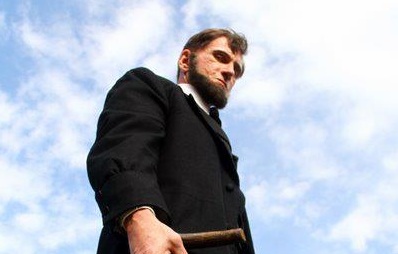
Abraham Lincoln vs. Zombies (2012) Movie Image
Op-Ed: Question everything - especially them
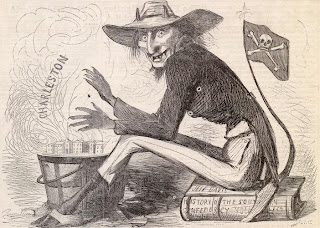 As a recovering Confederate-apologist, I have become quite sensitive to the propagation of Lost Cause mythology that is so pervasive among southern heritage bloggers today. Since my conversion I have come to realize that there is such a vast difference between writing Confederate history and worshipping it. I am most irritated over the Confederate-apologist’s constant use of the term “revisionist” when referring to anyone who disagrees with their version of the Civil War.
As a recovering Confederate-apologist, I have become quite sensitive to the propagation of Lost Cause mythology that is so pervasive among southern heritage bloggers today. Since my conversion I have come to realize that there is such a vast difference between writing Confederate history and worshipping it. I am most irritated over the Confederate-apologist’s constant use of the term “revisionist” when referring to anyone who disagrees with their version of the Civil War.
The implication of that statement is that the act of revision is a bad thing. This could not be further from the truth. Revision is actually good. Revision means to expand on - or correct. According to the textbook definition:
Historical revisionism is the critical re-examination of presumed historical facts and existing historiography, it is the reinterpretation of orthodox views on evidence, motivations, and decision-making processes surrounding a historical event. The constant revision of history is part of the normal scholarly process of writing history.
How can that possibly be looked upon as a negative? After all, what IS the study of history, but the search for deeper meaning? The fact of the matter is that these southern heritage folks have zero interest in deeper meaning. They are completely satisfied with their own versions of historical memory and have absolutely no desire to evolve in these perceptions. They also appear to live in constant fear of learning anything new. As if that is also a bad thing. I was once told by a southern writer that perhaps there isn’t anything new to add to the discussion. His exact words were: “Maybe there's nothing new to tell. I don’t seek the new - just the facts. New and faddish are related.” What?
You may have noticed that I don't really plug my first three books on this blog anymore. Why? Because I once felt the exact same way as these folks and it definitely skewed my historical interpretations. Thankfully I realized my bias and worked very hard on my last three books to correct that. Now I find myself debating the very same folks that I once considered kindred spirits. Fortunately my academic friends have been trying very hard to convince me that you cannot reason with these folks. They are fanatically set in their ways and they will not waiver. Don't try and debate them they say. Instead, question them…
Considering the overwhelming historical record, it's appropriate to ask: Why is it so difficult for so many Confederate apologists to admit that the ONE state's right that mattered above all else - according to the secessionists themselves - was the 'right' to own slaves? That the one type of 'property' that they were concerned with, above all else, was the nearly 4 million slaves that they owned? Worth several billion dollars in 1860 money - which translates into the equivalent of how many tens of billions, today?
I believe that many people are in fact sincere when they say things like 'heritage, not hate' and 'it wasn't really about slavery.' But the only reason they can say these things sincerely, I believe, is because they are genuinely ignorant of what the secessionists themselves wrote and said to justify their cause. We are simply not taught these things in history classes in school, not shown the original speeches and documents that make so clear what it was about. But with the 150th anniversary of the Civil War fast upon us, the historical revisionism will be coming fast and furious. So we had best be prepared to confront the apologists with the words and documents of the secessionists.
Ask them to explain the Confederate Constitution’s provisions on slavery. Ask them to explain the various declarations of the causes of secession put out by the states. Ask them to explain what the secession commissioners wrote and said, as official representatives of their states. And see if, once they are informed and educated, they can still bring themselves to romanticize the Lost Cause. - What Caused the Civil War: or, How to argue with a Confederate apologist
I embrace this newfound perspective not in an attempt to disrespect Confederate history or those who have an attachment to it...I simply believe that we do a great disservice when we alter historical memory in support of a preconceived notion or agenda. Unfortunately, this has become the norm among many so called "Pro-Confederate" heritage groups. Far too many folks are flat out ignoring or disregarding the issue of slavery, or propagating myths such as the Black Confederates.
In their efforts to legitimate their perspective, they are actually creating a false memory of their forefathers. This renders their credibility useless and nullifies their counter-argument capabilities.







 Like many of you I too spent my Saturday afternoon watching the live 6-hour broadcast of the Museum of the Confederacy’s Person of the Year: 1862 symposium on CSPAN-3 (
Like many of you I too spent my Saturday afternoon watching the live 6-hour broadcast of the Museum of the Confederacy’s Person of the Year: 1862 symposium on CSPAN-3 (
 I’m sure many of you have heard about the upcoming film titled “Abraham Lincoln: Vampire Hunter.” As both a historian and a film producer I cannot believe something this absurd found its way to the big screen. I suspect that it won’t break any box office records once it’s released. The mere concept of our 16th president hunting down vampires is absolutely ridiculous and with the continued ‘sissyfication’ of these bloodsuckers (courtesy of the Twilight Series) I don’t anticipate much of a scare.
I’m sure many of you have heard about the upcoming film titled “Abraham Lincoln: Vampire Hunter.” As both a historian and a film producer I cannot believe something this absurd found its way to the big screen. I suspect that it won’t break any box office records once it’s released. The mere concept of our 16th president hunting down vampires is absolutely ridiculous and with the continued ‘sissyfication’ of these bloodsuckers (courtesy of the Twilight Series) I don’t anticipate much of a scare. 
 As a recovering Confederate-apologist, I have become quite sensitive to the propagation of Lost Cause mythology that is so pervasive among southern heritage bloggers today. Since my conversion I have come to realize that there is such a vast difference between writing Confederate history and worshipping it. I am most irritated over the Confederate-apologist’s constant use of the term “revisionist” when referring to anyone who disagrees with their version of the Civil War.
As a recovering Confederate-apologist, I have become quite sensitive to the propagation of Lost Cause mythology that is so pervasive among southern heritage bloggers today. Since my conversion I have come to realize that there is such a vast difference between writing Confederate history and worshipping it. I am most irritated over the Confederate-apologist’s constant use of the term “revisionist” when referring to anyone who disagrees with their version of the Civil War.